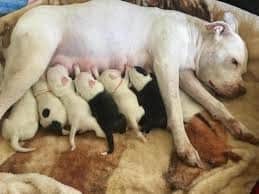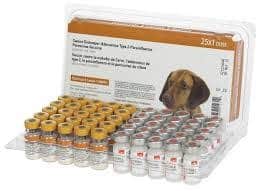A common disease amongst young puupies that aren’t fully vaccinated, is parvovirus. This virus attacks the cells of the intestine as well as the bone marrow and is often fatal without aggressive treatment. What some pet owners don’t realize, is this virus is preventable with regular vaccinations and some easy environmental control if your puppy or dog isn’t fully immunized yet.
Generally speaking, the biggest step in preventing parvovirus is vaccination. This virus exists virtually everywhere. It is hardy in the environment and easily carried on the surfaces of inanimate objects. Most puppies and dogs will be exposed and vulnerable at least for a time. Prevention is about minimizing exposure to the virus until the vaccination series is completed.
Maternal Antibody: Our Biggest Obstacle in Vaccination
The biggest problem in protecting a puppy against this infection ironically stems from its own natural mechanism of protection. As mentioned previously, puppies obtain their immunity from their mother’s first milk, the colostrum, on the first day of life. This special milk contains the mother’s antibodies against all the infections she has experienced or been immunized against, parvovirus included, and until these antibodies wane to ineffective levels, they will protect the puppy.

The problem is that they will also inactivate vaccine.
Vaccine is a solution containing a harmless version of the virus, either live and weakened (attenuated or modified live virus vaccine) or killed (inactivated virus vaccine). This virus is injected into the puppy. If there is still adequate maternal antibody present, the vaccine virus will be destroyed just as if it were a real infection. There will be a period of about a week when there is not enough maternal antibody to protect the puppy but too much to allow a vaccine to work. (This period is called the window of vulnerability.) After this period, vaccine can be effective.

If the mother has been well-vaccinated (booster vaccine given at approximately the time of breeding so as to maximize her colostral antibodies), an extra dose at 20 weeks may be a good idea to be sure all the maternal antibodies have waned adequately.To get around this, we vaccinate puppies in a series, giving a vaccine every 2 to 4 weeks until age 16 weeks or, as mentioned above, a little thereafter.
By giving vaccine at intervals we are trying to catch the puppy’s immune system after their window of vulnerability has closed. We know that by age 16 weeks, we should be able to get a vaccine to take but we still begin at a younger age in an effort to provide immunization as soon as possible, especially as some pups won’t have appropriate maternal antibodies.
Should Live or Killed Vaccine Be Used?
Killed vaccine is the least effective at penetrating maternal antibody. It is also associated with more vaccine reactions since more stabilizing chemicals are used in a killed vaccine. As a general rule, modified-live parvovirus vaccine is the best and most often used vaccination.
Vaccination Intervals
Giving vaccine more frequently than every 2 weeks will cause interference between the two vaccines and neither can be expected to be effective. This includes giving vaccines for different infections. Vaccines should be spaced 2 to 4 weeks apart.
It is commonly held that puppies need a certain number of vaccines for protection to be achieved (usually either three or four is the magic number). The number of vaccines given has nothing to do with protection. In order for protection to be achieved, vaccine must be given when it can penetrate maternal antibody.
Vaccinating Adult Dogs
Traditionally, parvovirus vaccine has been administered annually to all dogs. Vaccine against canine parvovirus has been included in the distemper combination vaccine (the DHLPP, “6 in one,” etc.)
Since the 1990s, some studies have shown that after a dog has been properly vaccinated as a puppy, that parvovirus vaccination can be done every three years. Many university teaching hospitals have switched to a 3-year schedule for adult dogs, plus the American Animal Hospital Association recommends that parvo vaccination be given to adult dogs on a 3-year schedule.
Read the AAHA vaccination guidelines.
What is the Meaning of a Vaccine Titer?
A vaccine titer is a blood test that measures the antibody level a dog is carrying against a certain virus. There are two methods of measuring parvovirus antibody titer: hemagglutination inhibition and serum neutralization. The result obtained, expressed as a ratio, refers to how diluted the dog’s serum (blood) must be for antibody to still be detectable. Based on work at Cornell University, the following titer levels are generally considered protective:
- Hemagglutination inhibition titer of 1:80 or more
- Virus neutralization titer of 1:20 or more
The virus neutralization titer is felt to be the most accurate representation of protection.
Most of the titer tests, unless done at specific universities, do not correlate to true challenge studies. In other words, even though it is thought to protect against infection, no one truly knows if a good titer correlates to protection against the virus in the face of a real exposure. Cornell University is one of the few labs that does have a titer test that has been found to reflect true immunity.
In most cases, titer tests are not needed. Instead, dogs should simply be vaccinated appropriately against the virus as adults. Titers are more important for a dog that has had a severe reaction to vaccination or has an auto-immune disease that may flare up if further vaccinations are given.
Protection after Infection
A puppy that has recovered from a parvovirus infection can be expected to have strong immunity. This has been tested out to 20 months after infection and immunity is believed to be lifelong; because this is unproven, continued vaccination is commonly recommended.
Prevention by Environmental Control
Because of parvovirus, puppies should not be allowed out in the public world until their vaccine series has been completed. This means not going for walks or to the park and not socializing with other puppies. There is some controversy regarding socialization of young puppies if they are kept isolated in this way until age 16 weeks; however, from an infectious disease standpoint, this is the safest way to go. If the home has previously housed a parvo infected dog or puppy, disinfection (especially removing fecal matter) is paramount. By getting an older puppy whose vaccination series is already complete, you can avoid this entire issue.


